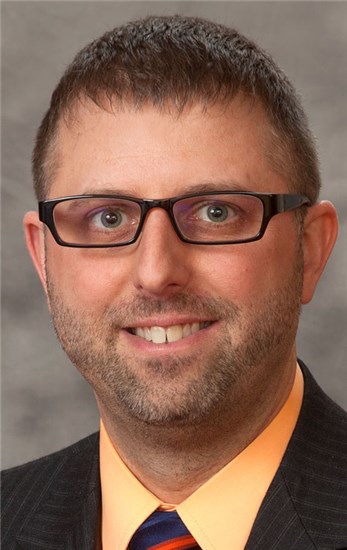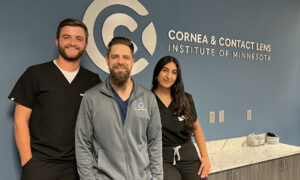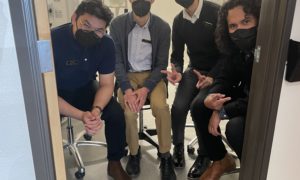By Dave Anderson, OD
Oct. 28, 2015
SYNOPSIS
Achieve practice growth by involving staff in the business, instituting their ideas to improve processes and profits—and rewarding them.
ACTION POINTS
SHARE FINANCES. Update staffon practicefinances and involve them in growth goals.
IMPLEMENT STAFF IDEAS. Put good ideas from staff to use, then track their impact on patients and profitability.
REWARD SUCCESS. Reward winning ideas with bonuses, gift certificates, time off, spa day retreats, or other perks.
A business means more to employees when they understand the business’s goals, and the challenges facing it. An optometric practice is no different. For that reason, I involvemy 19 staff members in our business planning process. Iencourage staff to share ideas, and let them know that our practice success depends as much on them as as on our doctors.
In fact, three great ideas from staff, incorporated over the past two years, have had measurable impact on our practice. And staff has been recognized and rewarded for such ideas.
Highlighting high-end products. We now use a separate display case for higher-end frames, which has boosted frames sales from 10 to 20 per month, resulting in $100 more per premium frame sale, equaling an additional $1,000 in sales per month.
Patients no longer fill out EHR forms independently. The forms were taking patients five minutes to fill out independently, and often needed further clarification in the exam room, or were still incomplete by the time they got to the doctor. Now, completion of these forms takes about three total minutes with the doctors and staff facilitating the history taking, and this saves us at least two minutes per patient, 180 patients per week, freeing up 360 minutes to focus on patient care.
Two staff meetings per month devoted to staff training. Two staff meetings per month were devoted to staff training. This includes topics that vary from training in diseases of the eye, why a progressive lens works different than a lined bifocal to why daily disposables are better for patients. The additional training resulted in two great things happening: Our teamwork improved as staff began to better understand the work of their colleagues, and overall staff knowledge of eyecare, and the operations of our office improved, enabling staff to speak more intelligently about the products and eye problems we handle every day.
Keeping staff involved helps them see how their work contributes to the success of the whole office. It is easy to overlook a small systems process if you don’t feel like your part matters. When all staff can see the correlation between positive reviews to increased revenue, or the purchase of new equipment or a new frame line and associated increased revenue, it is easier for them to understand the need to accommodate our patients’ needs. Every time a change happens in an office, some staff will be excited, some will be skeptical and some will just view the change as more work. If they are able to see the impact financially for the practice, and in turn, the increased ability for bonuses and pay raises, they will look at change as a positive, and not simply more work.
The staff of Dr. Anderson’s practice, Miamisburg Vision Care, along with Dr. Anderson and the practice’s two other partners. Dr. Anderson says employees are motivated when they are involved inpractice growth, and when theirideas are valued and implemented to meet practice goals.
Why It’s Worth Engaging to Motivate
Motivated staff can be defined in many ways. Motivation includes a positive attitude, great patient service and greater ability to make product sales. Motivated staff tend to work on their own without constant pushing, and do so with only overall guidance. Motivated staff also ensure the little things, like a clean waiting area and a friendly greeting, are done consistently.
The other thing motivated staff do is bring ideas to the practice. As a business owner, it is hard to be in tune with every aspect of the business. With so many areas that generate revenue, it is hard to have the constant pulse as to what is working and what is not.
We always give guidance on our expectations, and give deadlines for implementing new ideas or changes, but allow our staff to work on this from the perspective of their own experiences. The two big keys to encouraging staff to be independent thinkers for the benefit of the practice is to allow them to understand the financial impact of their ideas, and to show support for those ideas.
Mistakes are sometimes made, and as a leader, it is important to take ownership of those mistakes, but also to give credit where others have shined, and where their ideas were successful.
When staff are engaged and motivated, they go out of their way to help patients. I have seen staff open the door when someone was struggling to get inside. I have seen staff clean snow off the windshield of a patient’s car. I have seen staff walk over and hug a patient who was worried about a newly diagnosed condition. None of that happened because I told them to. All of it happened because they believe in our office, in our mission and have the same goals that I do as the owner–the best service for every patient who is now part of our family.
Find Ways to Make Greater Use of Staff
Involving staff in my business is a huge key to staff loyalty and staff motivation. This includes purchasing decisions, whether it is equipment or smaller items such as staplers, as well as cost-saving programs like buying groups.
Keep Staff Up-to-Date
I have always kept employees up-to-date as part of our weekly staff meetings. Our finances are reviewed office-wide on a monthly basis, but we also look at quarterly trends and review when an area is either showing a positive or negative trend. During our meetings, we have a set agenda where we review the financials, the patient reviews and any staffing or HR issues. This typically only takes a few minutes, and allows us to start the meeting off in a positive fashion, or in a way to remain focused on goals for the next month.
Inform Staff of Practice Financial Performance
At weekly staff meetings, we share details on revenue per patient each month, total number of exams, complete frame and lens sales and the break down of where the money is coming from. This allows us to work together to plan for future growth and look at areas that may dip in production periodically. Specifically, each staff member holds personal accountability when they know where the money comes from.
We have three areas that staff pay close attention to and track for our monthly meetings. One staff member watches closely the frames and lens area, including the total frame and lens profit and the sales per eye exam.
Our billing manager is responsible for tracking the accounts receivable, and gives a report on this, while our HR manager monitors the total revenue per patient and tracks this compared to positive and negative reviews for the office.
They are accountable to the numbers, and with the help of the doctors, they hold all the staff accountable to them, as well. —Dave Anderson, OD
Implement Employee Ideas
A year ago, one of our staff members suggested we purchase a separate display case for higher-end frames. She felt this would help us position our frames in a way that patients would ask about them specifically. She was right! This made an immediate impact, as not only did our higher-end frames look great; they also sold at a faster rate. We were selling 10 per month before this display, and after we added it, we began selling over 20 per month.
The increased high-end sales increased our monthly revenue by over $1,000. A simple change suggested by a motivated staff member can lead to great things for our office.
Just recently our staff recommended we only have patients who are not entered into our EHR system fill out entry forms. We no longer have patients fill out medical history forms which always included their name and contact information.
The medical history and eye history often remained the same, and the medications the patients are taking are now readily available in our integrated EHR. This allows us to simply confirm their address, health history and medications adding new items and moving on.
This new process for gathering patient data allows the staff and doctors to check all the existing items with the patient directly, and eliminates one of the most frustrating parts of our exams based on patient surveys. This has saved time, and led to better patient survey results, and most importantly, happier patients!
Reward Staff for Contribution to Practice Growth
We have used many ways to recognize employees for the great things they have done for our office and patients. We have done monetary bonuses, spa day retreats, random afternoons off and massage chairs in the office. All of these rewards have been appreciated by employees, and have kept our staff engaged and focused on the big picture of practice success. Each staff member has their own motivator, some like to be recognized, some like money, and some like time off. Ultimately, the big key has been to provide a little bit of each so every employee has something that pushes them to a better job performance.
In the near future, we plan to incorporate happy hour days for staff. We always get most busy in the afternoon, but there are some days that just simply slow down. Usually it’s around a holiday or big home football game. Since we know the pattern in our office, we can take advantage of this and pick a slow day and have fun together. This would be our whole office, as a staff, either having ice cream or a drink and appetizers together.
Dave Anderson, OD, is a partner withMiamisburg Vision Care in Miamisburg, Ohio. To contact: doca@burgvision.com




























